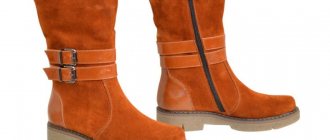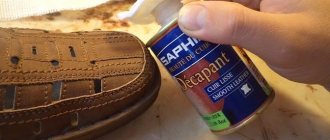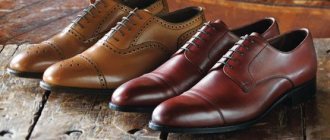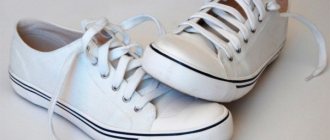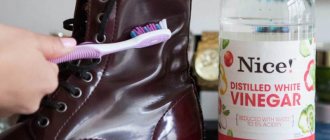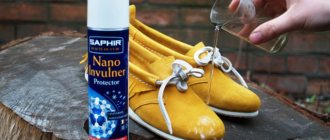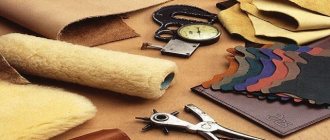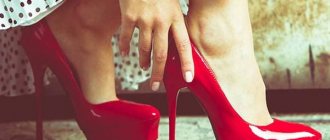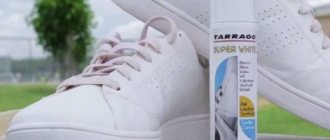As sad as it is to realize, over time any shoes become unusable. And if it is still suitable for wear, then its appearance evokes nostalgia for the time when it was first purchased. This is especially true for such comfortable and beloved shoes as sneakers. And it happens that it is not possible to buy a new pair or there is currently no product of the same quality on sale. For this reason, many are interested in how to paint sneakers to make an old item look like it was just purchased. And can shoes be repainted at all?
Yes, this task is doable. You can go to any shoe shop, where for a fee they will select the paint of the desired color depending on the type of material. But is it worth overpaying if, with a wide range of coloring agents for shoes, it’s quite possible to do it yourself. First you need to understand what the product is made of and decide on the scope of work.
Preparing shoes
Sneakers should be thoroughly washed to remove dust, remove dirt, and remove any remaining shoe polish and wax. Then you need to degrease the entire surface or individual areas to be restored. Special cleaners will help you cope with these procedures efficiently and quickly, but you can also use improvised materials. For example, a solution of laundry soap with the addition of ammonia will replace a store-bought product. Shoes should be dried well naturally, avoiding electric heating devices.
How to paint nubuck shoes
First of all, shoes or boots should be prepared for painting. To do this, the surface is thoroughly cleaned of visible and stubborn dirt, dust and stains.
Advice! A special double-sided brush with a rubber and soft fleecy coating will help with cleaning.
Recommendations:
- After cleaning, shoes should be dried naturally. It is important to avoid exposure to heating devices, as they have a negative effect on the material.
- It is advisable to carry out all work in the fresh air, as the paint has a strong odor.
- To avoid the appearance of streaks and stains, the floor covering is covered with newspapers or paper.
- The composition is applied in accordance with the attached instructions.
- In case of significant damage, application of several layers is recommended. For a high-quality result, each layer must dry thoroughly.
Attention! When performing the procedure at home, you should open the windows to provide fresh air. For additional protection, a respirator is useful.
To remove paint stains from the surface of the sole or heel, a clean flannel rag is suitable. After completing the procedure, the shoes must be dried naturally for several hours.
Nubuck shoes are particularly attractive and charming. Long-term use and aggressive environmental influences cause significant damage to the material, which causes the loss of its natural shade. Several methods will help you paint and renew your products yourself.
Cute DIY patchwork quilt
What are reinforced threads?
Painting sneakers made of leather and leatherette
Products made from such materials are easy to paint because their surface is smooth, the paint is distributed evenly, and as a result everything looks very neat. What paint to paint your sneakers is up to everyone to decide for themselves. Leather dye is sold in cream or liquid form. To obtain an ideal result, it is recommended to pour the dye into a separate container, which will allow the composition to be mixed evenly. The main condition is that the coloring agent must be applied in one step to avoid streaks. After drying, if necessary, the procedure can be repeated.
Many people are interested in how to paint white sneakers.
How to paint nubuck
An important point in dyeing shoes yourself is the correct selection of the composition. For work, it is recommended to choose paint designed specifically for this material. Manufacturers offer a wide range, among which it is sometimes difficult to make the right choice.
In order to provide nubuck shoes with additional protection, you should use a product such as an activator liquid. It will be useful not only in updating the color. This composition helps create a water-repellent layer that protects products from aggressive moisture. This will allow you to use the shoes in wet weather.
Reference! When purchasing, you should pay special attention to the presence of this impregnation, since it is not present in every composition.
The color palette is of particular importance. To update and maintain the natural shade, you should select a product in accordance with the original tone of the shoe itself.
Painting the sole
The sole of any shoe is most susceptible to damage. In sneakers, this is usually the most solid and high-quality part; only over time, the design can suffer significantly. But there are no problems here either, you just need to know how to paint the sole of your sneakers. Just like the upper part, it is possible to restore it completely (or some fragments). The paint is sold in stores in various colors. Numerous owners of sports shoes use automotive aerosol paints to paint the soles. The painting process and preparation is similar to the upper part of the shoe.
Maybe someone has their own recipe, but this article discusses the best options for how to paint sneakers.
When and why should you paint your shoes?
For such a demanding material as nubuck, you need to start caring for it even before wearing it. Before going outside, shoes must be treated with a water-repellent spray. In certain cases, to consolidate the result, impregnation is repeated. The decision to resort to painting nubuck shoes is made when:
- abrasions appear;
- the surface of the skin is damaged;
- shoes are scratched;
- faded color.
You will also need paint if you intend to completely or partially change the color.
Scuffs on shoes
How to restore nubuck shoes at home
To return your shoes to their original appearance, you should stock up on all nubuck care products. If the product needs minor restoration, then the following procedure is performed:
- All stains and dirt are removed from the surface using a special detergent;
- Next, the material is processed with a hard brush or eraser;
- After this, the shoes are allowed to dry naturally;
- The dried material is processed with a rubberized brush;
- At the end of the restoration, the shoes are impregnated with a water-repellent aerosol.
If simple procedures no longer help to restore a beautiful appearance, then you can use the hot steam method.
To do this, the shoes should be hung over a container in which water is boiling. The product is kept over steam until slightly moistened. Avoid getting too wet. As soon as the shoes have cooled, they should be combed with a stiff brush. Finally, the material is treated with suitable paint.
If grated areas appear, lightly scrub them with a metal brush or knife. In this way, you can restore shoes with large scuffs. Using a brush, the entire surface is “scratched” to achieve uniformity.
Kinds
Manufacturers use several types of nubuck - natural, artificial and hydrophobic (otherwise called nubuck-oil). Each of them has its own pros and cons, which are taken into account when manufacturing products:
- Natural nubuck is a material of animal origin that is made from animal skin. It is tanned using chrome and salts, then polished with abrasives and painted. The result is a soft, delicate, elastic, pleasant-to-touch material that is widely used in various fields, including the manufacture of shoes. But it does not like moisture, is capricious, less durable than ordinary leather, and needs special care.
- Artificial nubuck is made from synthetic polymers and does not use animal skin at all. Thanks to modern technologies, it is not inferior in quality to natural, and in some respects even surpasses it. Shoes made from artificial nubuck are durable, stain-resistant, soft and durable. Its downside is the need for careful care, just like its natural counterpart. In addition, being a completely artificial material, it does not “breathe”.
- Hydrophobic (oiled) nubuck is made from natural raw materials, but during production it is subjected to additional processing with special fat solutions. Thanks to this, it acquires water-repellent properties and becomes as if wet to the touch. Nubuck oil is more practical than other types and is better suited for daily wear. Its only drawback is that due to impregnation it becomes very heavy.
- How to treat pancreatitis of the pancreas at home
- Cardiac arrhythmia - causes and signs of the disease. Symptoms and treatment
- How to open an individual entrepreneur - instructions and necessary documents
Caring for dyed shoes
- Before storing a dyed nubuck product, it is better to place it in a fabric bag and put it in a box.
- In winter, after returning from the street, boots must be cleaned of reagents every time. They have a detrimental effect on this material.
- It is recommended to systematically use moisture-repellent agents. After application, you need to wait until it is absorbed.
- During the warm season, nubuck should be wiped off dust as often as possible with a damp cloth.
- To remove dust and dried dirt, it is recommended to use a steam generator. After the procedure, the top is wiped with a cotton pad.
- Under no circumstances should you dry nubuck on a radiator. Everything should dry naturally or at room temperature. Crumpled newspapers will help absorb excess moisture inside the product.
Wet cleaning
This cleaning method is carried out using special products that are designed to remove various stains.
In stores you can find shampoos, foams and other products aimed at cleaning nubuck fabric. When using these substances, you should follow the instructions in the instructions.
Sometimes a situation may arise that there is no special product at hand, and the shoes need to be cleaned. In this case, you can use the means at hand:
- Ammonia. This substance allows you to cope with white spots that form due to reagents getting on your shoes. Most often, salt stains occur in the spring, when people begin to actively use sidewalk sprinkles. For cleaning, ammonia is diluted with water in a ratio of 1:4. A sponge is moistened in the resulting solution and the contaminated areas are gently rubbed with it. After cleaning the shoes, let them dry and keep them over steam to straighten the pile. After the procedure, you can apply the appropriate paint and impregnation. Fresh stains can be easily removed with a simple damp cloth. The main thing is not to press too hard so that the material does not get wet;
- Vinegar. Vinegar works well on salt and dirt stains. You will need 1 teaspoon of product and 1 liter of cool water. Everything is mixed, and a cotton pad is soaked in the solution. The dirty area is thoroughly cleaned. After this, the shoes are dried and the pile is combed;
- Salt. This product allows you to remove greasy stains. Pollution is awakened with a pinch of salt. Using a sponge, lightly rub the product into the stain. The salt should be changed several times during the cleaning process. After processing, all residues are removed with a damp cloth, and the product is left to dry completely. If nubuck shoes are white, you can use chalk or talc;
- Stale bread. Simple stains can be easily removed with a crust of bread. The crust acts as a brush. Therefore, the bread should be dry and stale;
- Solvents. Stains left by vegetable oil can be removed with organic solvents. These include: gasoline, alcohol, kerosene, turpentine and ammonia. The selected substance is tested on a small area of fabric to check its interaction with the material. For cleaning, a weakly concentrated solution is prepared. A cotton swab is moistened in the selected solution. Use gentle circular movements to treat the stain. The product is left on the dirt for a while and then removed with a damp cloth;
- Coffee grounds. This method is only suitable for dark products. Coffee grounds are rubbed into the contaminated area and left for about five minutes. Using a sponge, dirt is removed. All residues are wiped off with a damp cloth. This method not only gets rid of stains, but can also paint worn areas.
Rubber
Rubber boots are a lifesaver on rainy autumn days. But sometimes the stores don’t have the color you would like to purchase, so you have to look for dyeing products and do it yourself.
Preparation and tools
If you decide to eliminate defects or make the color rich and bright, first prepare the boots.
The first stage is washing the products. Rubber is not afraid of water, so feel free to wash with dishwashing detergent, hair shampoo or other cleaning agents to remove dust.
Leave the shoes to dry. Then the surface should be degreased. To do this, use medical or ammonia.
Do not use nail polish remover for degreasing. Acetone will corrode paint. Why create unnecessary problems?
Today the choice of funds is very diverse. Shoe, construction and hardware stores will show you a variety of compounds that can be used to paint rubber boots. For these purposes, use enamel paint, acrylic or any other that can be used for rubber.
Process
How to dye shoes at home? You won't be able to completely update your tires on your own. Even if you paint with special paints on rubber, the surface will appear uneven and the layer of paint on top of the shoes will be very noticeable.
The only solution to this problem is decoration. Buy stencils with the patterns you like at the store and use them to disguise damage and scuffs.
You can also use nail polish and paint something in the right place, choosing a color scheme. You are lucky if you are talented and know how to draw beautifully.

